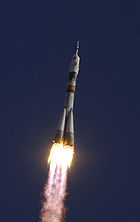 Sputnik rocket Sputnik rocket | |
| Function | Early (first) carrier rocket |
|---|---|
| Manufacturer | OKB-1 |
| Country of origin | USSR |
| Size | |
| Height | 8K71PS: 30.0 m (98.4 ft) 8A91: 31.1 m (102 ft) |
| Diameter | 2.99 m (9.8 ft) |
| Mass | 8K71PS: 267,000 kg (589,000 lb) 8A91: 269,300 kg (593,700 lb) |
| Stages | 2 |
| Capacity | |
| Payload to LEO (8K71PS) | |
| Mass | 8K71PS: 500 kg (1,100 lb) 8A91: 1,327 kg (2,926 lb) |
| Associated rockets | |
| Family | R-7 |
| Comparable | Vanguard Juno I |
| Launch history | |
| Status | Retired (No Longer In Use) |
| Launch sites | LC-1/5, Baikonur |
| Total launches | 4 (2 8K71PS, 2 8A91) |
| Success(es) | 3 |
| Failure(s) | 1 (8A91) |
| First flight | 8K71PS: 4 October 1957 8A91: 27 April 1958 |
| Last flight | 8K71PS: 3 November 1957 8A91: 15 May 1958 |
| Type of passengers/cargo | Sputnik 1 Sputnik 2 Sputnik 3 |
| Boosters (Block B, V, G, D) | |
| No. boosters | 4 |
| Powered by | 1 RD-107 |
| Maximum thrust | 970 kN (220,000 lbf) |
| Specific impulse | 306 s |
| Burn time | 120 s |
| Propellant | LOX/Kerosene |
| First stage (Block A) | |
| Powered by | 1 RD-108 |
| Maximum thrust | 912 kN (205,000 lbf) |
| Specific impulse | 308 s |
| Burn time | 330 s |
| Propellant | LOX/Kerosene |
| [edit on Wikidata] | |
The Sputnik rocket was an uncrewed orbital carrier rocket designed by Sergei Korolev in the Soviet Union, derived from the R-7 Semyorka ICBM. On 4 October 1957, it was used to perform the world's first satellite launch, placing Sputnik 1 into a low Earth orbit.
Two versions of the Sputnik were built, the Sputnik-PS (GRAU index 8K71PS), which was used to launch Sputnik 1 and later Sputnik 2, and the Sputnik (8A91), which failed to launch a satellite in April 1958, and subsequently launched Sputnik 3 on 15 May 1958.
A later member of the R-7 family, the Polyot, used the same configuration as the Sputnik rocket, but was constructed from Voskhod components. Because of the similarity, the Polyot was sometimes known as the Sputnik 11A59.
Specifications
- First Stage: Block B, V, G, D (four strap-on boosters)
- Gross mass: 43.0 tons
- Empty mass: 3.400 tons
- Thrust (vac): 4 × 99,000 kgf = 396 Mgf (3.89 MN)
- Isp: 306 s (3,000 N·s/kg)
- Burn time: 120 s (2 min)
- Isp (sl): 250 s (2,450 N·s/kg)
- Diameter: 2.68 metres (8.8 ft)
- Span: 2.68 metres (8.8 ft)
- Length: 19.2 metres (63 ft) (without nozzles)
- Propellants: LOX/Kerosene
- Engines: 1 x RD-107-8D74PS per booster = 4
- Second Stage: Block A (core stage)
- Gross mass: 94.0 tons
- Empty mass: 7.495 tons
- Thrust (vac): 99,000 kgf (970 kN)
- Isp: 308 s (3,020 N·s/kg)
- Burn time: 310 s (5 min 10 s)
- Isp (sl): 241 s (2,360 N·s/kg)
- Diameter: 2.95 metres (9.7 ft)
- Span: 2.95 metres (9.7 ft)
- Length: 28 metres (92 ft)
- Propellants: LOX/Kerosene
- Engine: 1 x RD-108-8D75PS
- Total mass: 267 tons (589,000 lb)
- Total span: 10.303 metres (33.80 ft)
- LEO payload: 500 kg
- Total liftoff thrust: 3.89 MN

Sputnik 8A91
The Sputnik 8A91 had more powerful 8D76 and 8D77 engines installed, increasing its payload capacity, and allowing it to launch much heavier satellites than Sputnik 1 and Sputnik 2. It was launched two times, in 1958. The first launch, on 27 April, failed due to vibrations that unexpectedly occurred during the flight along the longitudinal axis of the rocket. On 15 May, it successfully launched Sputnik 3.
Sputnik specifications
- Stage number: 0 - Strap-on boosters; 4 x Sputnik 8A91-0
- Gross mass: 43.0 tons
- Empty mass: 3.400 tons
- Thrust (vac): 4 × 99,000 kgf = 396 Mgf (3.89 MN)
- Isp: 310 s (3,040 N·s/kg)
- Burn time: 130 s (2 min 10 s)
- Isp (sl): 252 s (2,470 N·s/kg)
- Diameter: 2.68 metres (8.8 ft)
- Span: 2.68 metres (8.8 ft)
- Length: 19.2 metres (63 ft) (without nozzles)
- Propellants: LOX/Kerosene
- Engines: 1 x RD-107-8D76 per booster (4 total)
- Stage number: 1 - Core stage; 1 x Sputnik 8A91-1
- Gross mass: 95.0 tons
- Empty mass: 7.100 tons
- Thrust (vac): 82,000 kgf (804 kN)
- Isp: 315 s (3,090 N·s/kg)
- Burn time: 360 s (6 min)
- Isp (sl): 246 s (2,410 N·s/kg)
- Diameter: 2.95 metres (9.7 ft)
- Length:28 metres (92 ft)
- Propellants: LOX/Kerosene
- Engine: 1 x RD-108-8D77
- Total mass: 269.3 tons (593,700 lb)
- Total span: 10.303 metres (33.80 ft)
- LEO payload: 1,327 kg (2,925 lb)
- Total liftoff thrust: 385,950 kgf (3.784 MN, 850,870 lbf)
See also
SATCAT (No. 1. The satellite has SATCAT No. 2.)
References
- (in Russian) Sputnik Rocket Archived 2005-01-03 at the Wayback Machine
- "РД-107 и РД-108 | RD-107 and RD-108". lpre.de. Retrieved 2015-12-24.
- "Jonathan McDowell's launch log". planet4589.org. Retrieved 2015-12-24.
- (in Russian) Soviet Solar Cells on Orbit
- "Sputnik 3". astronautix.com. Archived from the original on 2013-11-08. Retrieved 2015-12-24.
- "Sputnik 8A91". astronautix.com. Retrieved 13 May 2023.
- "SL-1 R/B". n2yo.com.
| Soviet and Russian launch vehicles | |
|---|---|
| Active | |
| In development | |
| Retired | |
| Cancelled (no launch attempts) | |
| R-7 rockets | |||||||||||
|---|---|---|---|---|---|---|---|---|---|---|---|
| Missiles |  | ||||||||||
| Launch systems |
| ||||||||||
| Launch sites | |||||||||||
| Launches | |||||||||||
| Engines | |||||||||||
| See also | |||||||||||
Categories: